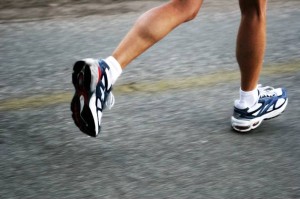 One of the most common complaints with runners is pain in the hips, pelvis area, or hamstrings, often just on one side. These injuries can be frustrating because rest from running and some basic stretching and TLC to the area often does not resolve the problem. The first step in managing these injuries is getting a clear bio-mechanical diagnosis, which mean not only identifying the pain source, but also pinpointing the root cause that is putting stress on that area. Common medical diagnoses include: hamstring strain / overuse; piriformis syndrome; SI or sacroiliac joint pain; and outer hip pain / tendinitis / bursitis.
One of the most common complaints with runners is pain in the hips, pelvis area, or hamstrings, often just on one side. These injuries can be frustrating because rest from running and some basic stretching and TLC to the area often does not resolve the problem. The first step in managing these injuries is getting a clear bio-mechanical diagnosis, which mean not only identifying the pain source, but also pinpointing the root cause that is putting stress on that area. Common medical diagnoses include: hamstring strain / overuse; piriformis syndrome; SI or sacroiliac joint pain; and outer hip pain / tendinitis / bursitis.
As mentioned in previous Colorado Marathon articles, bio-mechanically, running is not unlike walking or crawling and there needs to be some degree of symmetry in the reciprocating motions through the hips, pelvis, ribcage, and torso. When your pelvis is slightly twisted, or range of motion in the hips is asymmetrical, the neuromuscular system is forced into a compensatory mode to simply stabilize the body against the forces of gravity, and to generate forward motion. For those experiencing one of the above listed pain issues, a good physical therapist should be able to work through the following “flow chart” of clinical decision making to resolve the problem.
- Is there a pelvic asymmetry that results in loss of hip range of motion?
- How is your ability to isolate key pelvic/hip/core stabilizing muscles with isometric manual muscle testing? These tests give insight into how well you are recruiting key muscles during the dynamic activity of running.
- Almost all running injuries present with altered muscle recruitment patterns (which can lead to weakness), habituated through hundreds of miles of running. In coming years you will hear more and more about the neurological aspect of muscle firing patterns, and you will hear less and less about the approach of just stretching whatever is tight.
Here are some things you can look for on yourself that could indicate a bio-mechanical imbalance. Remember, these things may not produce an injury until your overall mileage or long runs increase and the imbalance gets “exposed”.
Standing posture: Do you tend to stand predominantly on your right leg with the right hip kicked out to the side; much more so than standing on the left?
Driving posture: Do you notice that when driving, your left leg is constantly splayed out and resting on the car door?
Lying posture: When lying on your back with legs completely relaxed do you notice that one foot/leg is more turned out than the other?
To read more, Click here to download article

0 Comments